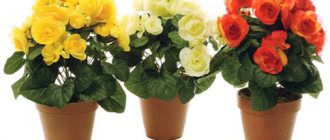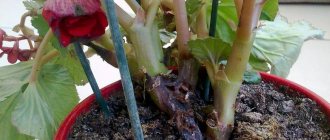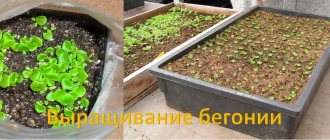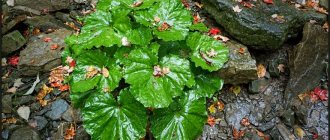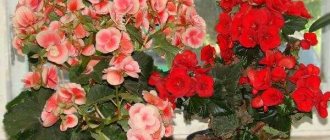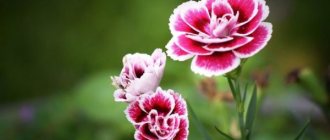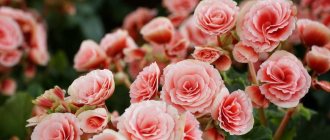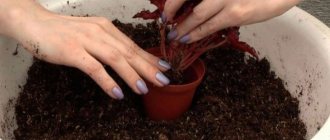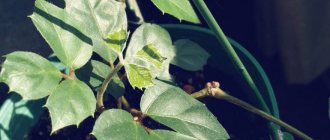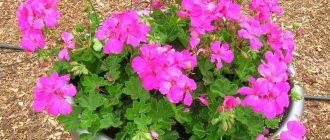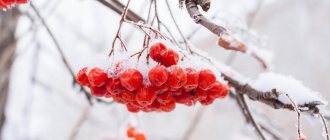Begonia has quite complex classification systems that divide plant species and varieties into different groups. Some divide them by the method of use in floriculture, others by the type of root system or method of propagation. We decided to take a simpler approach and conditionally divide begonia varieties into decorative deciduous and decorative flowering. In this article we will introduce you to the most beautiful types of decorative deciduous begonias. They are valued for the unusual shape, texture and coloring of their leaves. Although many of them bloom, their flowers are so inconspicuous that gardeners prefer to remove them so as not to spoil the spectacular appearance of their pet.
Description
So, decorative deciduous begonias usually grow in the form of a lush bush. The leaves are shaped like an asymmetrical heart. There are rounded leaves, carved leaves, and twisted leaves, with a jagged or wavy edge. The color of the leaf surface is very diverse: single-color, two-, three-, even four-color leaves combine shades of green, white, silver, burgundy and brown. There are leaves with a contrasting border and splashes of all shades. The leaf surface is decorated with pronounced veins. Such begonias can grow up to two meters in height or more, but have very small, inconspicuous flowers.
Temperature and humidity
Decorative foliage begonia is a southern plant; it loves warmth. For normal development of the crop, maintain a temperature of +20 to +25 °C. When it drops to +16 °C, the beauty often develops putrefactive diseases, which leads to the death of the plant. Therefore, if your room is cool in winter, then reduce watering the crop to a minimum.
Begonia does not tolerate dry air. And it is important to regularly maintain high humidity near the pot. At the same time, it is not recommended to spray the plant, since this leaves white spots and stains on its leaves, spoiling the decorative effect of the flower. To cope with this problem, place containers of water or humidifiers near the pot. And in winter, be sure to cover the central heating radiators with damp towels.
Mallet
The Mallet type includes decorative deciduous bushes with reedy stems and leaves of unusual texture, color and shape. Almost all of them are hybrids between cane begonias and begonias of other groups.
Begonia "Arthur Mallet"
A typical representative of Mallet is the Arthur Mallet variety. This unpretentious plant has unusually beautiful leaves with a satin pink glow.
Diseases and pests
The greatest danger to beautifully flowering begonias is powdery mildew. Most often, it is recommended to immediately destroy the infected plant, since control even with the use of fungicides rarely brings positive results, and begonia almost always dies or loses its decorative effect so significantly that it is more expedient to save it by propagating it from cuttings. Gray rot (when the soil is waterlogged) and aphids are also found on flowering begonias, which are best dealt with immediately with insecticides.
Common growing problems:
- the appearance of spots on the leaves when drops of water get in contact with them;
- dropping buds in drafts or during sudden temperature changes;
- dropping leaves in the cold;
- blanching of leaves and elongation of shoots with strong shading;
- Drying of leaf edges and browning of leaves in direct sun or extremely dry air.
Begonia cucullata
Spotted or Speckled (Maculata Raddi)
Begonia "Spotted" or "Speckled"
This is a bush type of begonia, a herbaceous subshrub with an erect stem, which under favorable conditions reaches about a meter in length and width. Therefore, it is grown most often in greenhouses and winter gardens. It has elongated, asymmetrical leaves in the shape of a heart with an oblique center. Their length is 10-15 cm, width - about 5 cm. The tip is pointed. Visually, the leaves resemble angel wings in their shape. (For this similarity, our grandmothers called this begonia that way). The leaf plates are very dense and glossy. Their rich green background is literally dotted with silvery-white spots. The back side of the leaves has reddish-brown-red shades. The petioles are short, about 2 cm. The flowers are of unusual shape, white or light pink. They are formed on a drooping peduncle hanging down in small inflorescences from April to July.
Coral (Corallina)
Previously, it was a separate species of begonia. Now they believe that this is a synonym for the “Spotted” begonia, i.e. its subspecies. This lush bush plant (over half a meter in height and width) has elongated-ovate leaves (up to 25 cm in length and up to 7 cm in width), with a serrated edge and a sharp tip. Their color is dark green, with white and silver inclusions in the form of spots or splashes. With the arrival of summer, a reddish tint appears on the back of the leaf. Flowering usually begins in spring. The buds are formed on the basis of fused petals of all shades of red, making the inflorescences look like luxurious berry clusters hanging down. The aroma of flowers is very subtle and refined.
Begonia "Coral" has its own popular varieties: "Lucerna" and "President Carnot".
Begonia "Lucerna"
Begonia "Alfalfa" is a reed begonia. Its stems are straight, more than a meter in height. The leaves are large, oval-heart-shaped, with distinct veining and a coarsely toothed edge. The leaves are dark green with white or silver specks, stripes or spots. The reverse side of the leaves is red-brown. Flowering occurs from March to September.
Begonia "President Carnot"
This is a bush with shield-shaped leaf blades, dissected at the base, and with a slightly toothed edge. The leaves reach 30 cm in length and 15 cm in width. Their green leaf surface is decorated with whitish spots.
This may be interesting: Caring for Philodendron at home
Leaf propagation
It is better to hold this event in April. To propagate decorative deciduous begonia, select a healthy large leaf and cut it with a sharp knife. Trim the stem so that it is 2 cm long. Leave the sheet for half an hour to dry slightly. After this, plant the plant in a flat container filled with moist universal soil. Don't forget to place a drainage layer on the bottom of the dish. Deepen the plant exactly to the surface of the leaf, and try to keep it lying on the surface of the ground.
Caring for the seedling consists of regular watering. Moisten the soil with a spray bottle with warm, settled water, preventing the soil from drying out. The optimal temperature for seedlings is +20 °C. After 3-4 weeks the leg will sprout. When the seedling is strong enough, transplant it to a permanent place.
Carolineifolia
Begonia "Carolinafolia"
This begonia is one of the oldest domestic flowers. Her homeland is Mexico. The thickness of the creeping shoot is about 4 centimeters. Large palmately dissected leaf plates are placed on long, up to 40-45 cm, yellow-green petioles. The leaves do not exceed 35 cm in length. Their surface is covered with clearly visible veins. As the leaves age, they fall off, leaving marks in the form of scales on the stems. Pinkish or yellowish-green flowers are part of loose, brush-shaped inflorescences. Flowering begins in February.
Propagation by seeds
This method is quite simple and does not require special skills. Start the procedure in February. Sow the seeds of decorative leafy begonia in a special substrate or on peat tablets. Cover the top of the planting with glass or film. Regularly spray the seedlings with a spray bottle.
When the shoots appear, begin to harden them. To do this, first remove the cover for an hour and gradually increase the time. As soon as 2-3 true leaves appear on the plants, plant them in a separate container. When the sprouts are fully grown, plant them in permanent pots.
Metallica
Begonia Metallica
This is a subshrub with strong, erect, well-branched shoots. This type of begonia received its name due to the shade of the leaves: on the reverse side they are purple, but on the front side they are green with red veins and a metallic tint. The stems and leaves are entirely covered with short bristles. It blooms from spring all summer with small whitish flowers covered with pinkish hairs on the outside. Metallica does not tolerate either stagnation of moisture in the pot or drying out of the soil. It must be watered systematically, but moderately. We recommend growing it in bright, warm and cool rooms, hallways; it grows well even on the northern windows of cold greenhouses.
Crednera or Pig's ear (Credneri)
Begonia "Crednera" or "Pig's ear"
The variety was obtained by crossing Metallic begonia and Scarf begonia. The leaves are light green with a metallic sheen on top and bright pink underneath. In the light they shine through like the auricle. Bush type.
Transplantation and substrate
Beautifully flowering begonias are replanted immediately after flowering or before growth begins, very early, in February. The strategy of transplanting after flowering is considered safer. The plant is pruned and then transferred to a fresh substrate. Very mature plants can be replanted once every 2 years, but annual replanting is usually carried out.
The selection of substrate for begonias is very important. Beautifully flowering begonias do not tolerate soil compaction, and the soil mixture should be loose, breathable and light. There are special substrates for begonias on sale, but a mixture with a fairly fibrous structure is also suitable (a combination of heather and garden soil with manure in a ratio of 5:5:1, turf soil with peat, humus and sand in equal proportions, etc.).
Slightly acidic substrates with pH values from 5.5 to 6.5 are preferred. Perlite or vermiculite can be added to the soil to improve breathability.
Transplantation of beautifully flowering begonias is carried out carefully, removing the free soil at the bottom of the earthen ball, but trying to avoid contact with the surface root system. The main task is to lay high, powerful drainage at the bottom of the container.
For beautifully flowering begonias, wide containers with a depth less than their diameter are preferred. To reduce the risk of soil waterlogging and optimize air exchange in the substrate, it is better to choose fairly compact containers (traditionally, even large flowering begonias are grown in containers with a diameter of about 14 cm).
Royal or Rex (Rex)
This perennial herbaceous plant came to us from the tropical forests of Eastern India. Grows only indoors. This begonia is not tall, growing up to a maximum of half a meter in length. It has a thick creeping rhizome protruding above the soil surface. The stem is lodging, creeping, and eventually drooping (rhizome). Its leaves are large, broadly oval, very decorative. Their size reaches 30 cm. They have a heart shape at the base and sharp edges. There are other names - “Napoleon’s Ear”, “Elephant Ears”.
The color of the leaves, depending on the variety, can be dark green, bronze-brown with silver spots, or cherry red with a metallic sheen. The upper surface of the leaf is velvety, slightly pimply, covered with short hairs. On the reverse side it is cut with convex red veins. As a result of crossing with other species and varieties, unusual hybrids with spirally twisted or fringed leaves appeared. The plant is unpretentious in care. It blooms with such modest, inconspicuous flowers that they are removed. The variety of leaf shapes and their bright beauty more than make up for the lack of flowering.
Popular varieties and hybrids of Royal Begonia
Begonia "Mini Merry Christmas"
This hybrid was bred in 1978. This is the most variegated variety of royal begonia. The average height of the bush is 30 cm. The top of the leaves is velvety, and the lower part is cut with large veins. The color changes from the center of the leaf to the edges. In the middle it is brown, then turns into red-crimson and becomes greenish-white at the edge with pearlescent splashes.
Begonia "Escargot" or king snail (Escargot)
Escargot is a low (up to 30 cm in height) and wide (up to 45 cm in width) decorative bush with large rounded leaves. It is distinguished by a two-color leaf color: the central part and edges of the leaf blades are painted brown-olive, and between them there is a wide stripe of silver color. The leaf surface is matte, it is covered with tiny burgundy hairs. At the base, the leaves are also twisted into a double spiral.
Begonia "Cartagena"
It has oval leaf plates of dark green color, which are wrapped in a shell. The center of the leaf is dark brown, but becomes plum-colored as it ages. Silvery spots are scattered on the green background of the leaf plate, which are sometimes illuminated with a light pink glow.
Begonia “Chocolate Cream”
This variety of begonia is distinguished by a large leaf with a spiral-twisted base. The central part of the leaf plate is painted a rich plum color. The veins and fringed edge are a vibrant dark brown. Most of the leaf glows with a silvery-pink tint. Beautiful!
Begonia "Silver Greenheart"
It has large silvery leaves with an oblique heart-shaped shape. The edges of the leaves are decorated with a wide border of emerald green, dotted with silver spots.
Begonia 'Evening Glow'
This hybrid has medium-sized leaf blades. Their central part has a rich crimson color, from which brownish-green veins radiate. Brownish-green veins radiate from the center along part of the crimson-colored leaf. There is a crimson border along the edge.
Begonia "Dollar Down"
The compact bush has a height of 25-30 cm. Its cherry-red leaves are decorated with a dark border. The shape of the leaf plate is fan-shaped, spiral-shaped, its size increases from the middle to the edges.
Begonia "Pearle de Paris"
Well branched bush. It is characterized by medium-sized leaves of gray-silver color with dark, clearly visible veins.
Begonia "Regal Minuet"
An instance of this variety is a small bush with paper-thin leaves that turn bright burgundy in good light. In low light, the color changes noticeably and becomes silvery-pink. At the same time, the border and center of the leaf plate are painted brown.
Begonia "Grifon"
This strong and durable begonia bush reaches a height of 40 cm. Its leaves are large, lush, shaped like the open paw of a griffin, dark green in color with a silver pattern. They are located on long petioles.
Begonia "Lilian"
Begonia Lilian has large emerald green leaves covered with silvery peas that turn pink at the base. The border is wide, burgundy-brown. The leaves at the base are twisted into a double spiral.
Begonia "Black Mamba" (Dark Mamba)
It differs in the way the leaf blades grow - it is spiral-shaped. The color of the leaves is also impressive - the deep dark green color appears completely black, and the reverse side of the leaves is cherry brown.
Begonia "November Frost"
The bush is small. The leaves are similar to maple, twisted into a spiral at the base. The main color of the leaf is silver, and the central part, numerous small veins and the border along the edge are dark brown.
Begonia "Black Fang"
This is an amazingly beautiful variety of begonia. Its leaves are twisted into a double spiral. They are velvety, black-olive in color with thin lemon veins. The underside of the leaf is bright crimson. The bush is compact. Requires good lighting.
Begonia "Black Prince"
Dark, almost black velvety leaves with carved, coarse-toothed edges, the underside of the leaf is red-brown.
Begonia "Hallelujah"
This hybrid has large, spirally twisted purple leaves with a silver coating at the petioles. The central part and edge of the leaves are cherry-colored, and between them there is a fairly wide strip of rich green color with numerous silver spots.
This may be interesting: Tillandsia epiphytes: atmospheric, usniform and others
Mason or Maltese Cross (Masoniana)
Begonia "Mason"
This is an amazingly beautiful type of indoor begonia. The bush is compact and effective. The roots are creeping, thickened and covered with numerous hairs. The pimply leaves of begonia are rounded-angular, asymmetrical, light green in color. In the center of each sheet is a crimson design resembling a five-fingered Maltese cross. With age, the general background of the leaves becomes silvery.
Red leaf (Erythrophylla or Feastii)
Begonia Redleaf
This plant has another name among gardeners - “Pista”. It has a slightly shortened stem, erect, with nodes. Long cuttings and whole or cut into several segments round leaves, the surface of which is dense, smooth, almost glossy. The front side of the leaves is green, and the back side is red, brownish or purple with well-drawn white veins. The edge of the leaf is jagged or wavy. Flowering occurs from December until spring. The color of the flowers is white, pink, yellow, red with frames of various shades.
How to propagate begonia?
Do you really want to increase the number of these beautiful plants in your home? Then you need to know everything about the methods of propagating begonias in order to choose the most suitable ones for yourself.
IMPORTANT! Decorative deciduous begonia must be constantly renewed and this is best done with the help of cuttings.
Reproduction methods:
- seeds (material for planting is purchased at flower shops);
- leaves;
- stem cuttings.
One leaf, two leaves
The leaf propagation method is one of the most popular and simplest, and I grew my own begonia from just such a leaf.
To do this, you need to select a leaf on the plant, carefully cut it, let the cut dry slightly, and then plant the leaf in a prepared container with substrate. Some gardeners first put the leaf in water, wait for small roots, and then plant it in the ground.
Reproduction by stem
Propagation of begonia by stem cuttings gives good results; for this you need to select either young shoots or already slightly lignified parts. Prerequisite: presence of kidneys.
Leaves are removed from the cuttings, an oblique cut is made and placed in prepared pots with substrate. It is advisable to cover the top of the cuttings with film, but be sure to remove it for ventilation and watering. It is the film that will create the necessary greenhouse microclimate for begonias, and they will quickly take root. But as soon as the plants get stronger, the film must be removed so that the begonias can adapt to the room temperature.
IMPORTANT! Decorative deciduous begonia needs regular renewal, in which case you will always have beautiful plants with spectacular greenery.
Hogweed (Heracleifolia)
Begonia "Horseweed"
This plant is native to Brazil. It got its name due to its resemblance to the leaves of the Hogweed plant, common at that time. Now this begonia is a very popular plant in home gardening. It has thick, green or cherry-brown stems with long, dense fibers. It is distinguished by its asymmetrical leaf blades - they are large (in nature up to 30 cm), palmately dissected, with sharp serrated edges and a heart-shaped base. The leaves are colored in green, cherry-red or red-brown tones, and the saturation directly depends on the level of illumination. Silver-gray veins are relatively evenly distributed over the entire surface of the leaf. The peduncles are long, the inflorescences are enlarged with small, inconspicuous light pink flowers of irregular shape.
Collar (Manicata)
Begonia "Collar"
This is a very unpretentious variety for home cultivation. The bush is quite large and spreading. It has large light green leaves, the diameter of which reaches 30 cm. Their upper part is glossy, and the lower part is covered with “cilia”. The edges of the leaf blades are cut and covered with small fibers. This begonia got its name because at the place where the cuttings are attached to the leaf, a kind of “cuff” is formed from red hairs.
This may be interesting: Fatshedera - home care
Tiger
Begonia "Tiger"
This species is native to Mexico. It has gained popularity due to the exquisite beauty of the leaves, the compact shape of the bush and its ease of care. Small white flowers appear in winter, but gardeners usually remove them so that they do not take away the strength of the begonia and the nutrition of the leaves. (Do the same with old leaves). The tiger begonia has virtually no above-ground stem; long drooping leaves grow directly from the root system. The bush reaches only 30 cm in height. The color of the leaves is remarkable: green, with spots of light green, brown or black. The reverse side of the leaves is pubescent. This species is rarely found in nature. But flower growers are happy to grow many of its hybrids indoors. Tiger begonia is unpretentious and grows well in shade and partial shade.
Bowera
It is a hybrid of tiger begonia. This is a small indoor plant, up to 15 cm high. It has heart-shaped, velvety leaves with rounded edges, an unusual tiger color: light green, bronze-tinged spots stand out sharply against a dark, almost black background. The edges of the leaves are framed with milky white cilia, and the veins stand out very clearly. The leaves are attached to long red cuttings. Peduncles appear in spring directly from the rhizome (creeping), on which basal rosettes are formed. The flowers are collected in brushes - umbrellas. Bauer's begonia also has its own hybrids:
Begonia "Black Velvet"
Grows in the form of a bush. Its stem is creeping, spreading along the surface of the soil. Star shaped leaves. They are dark chocolate, almost black, with velvety edges. The petioles are covered with light hair. It blooms with inconspicuous whitish flowers, which, surprisingly, look fascinating on the black velvet of the leaves.
Begonia "Cleopatra" (American Maple, Boveri, Maple-leaved)
This begonia reaches a height of 50 cm. It has a thin, erect, branching stem covered with hairs. The species is valued for its unique leaves. They are large, olive-colored on top with white veins, and red-burgundy on the back. The leaf blades are finger-shaped and covered with small light hairs. During flowering, a tall peduncle appears on the bush, in the lower part of which small inflorescences of white and pale pink color with a yellow center are formed.
Caring for decorative deciduous begonias at home
Deciduous begonias are unpretentious and hardy plants. They can react to mistakes in care and various problems by losing leaves and becoming depressed, but as soon as you correct your mistakes, they quickly recover. But still, it is better not to go to extremes in growing deciduous begonias.
If you provide them with regular and attentive care, begonias will reveal all their unprecedented beauty and become a true decoration of the collection. Moreover, it is not at all difficult to adhere to the “norm”: deciduous begonia does not require either a cool winter or measures to humidify the air.
Lighting for deciduous begonias
Due to their undemanding requirements for lighting, begonias allow the use of luxurious variegated leaves to decorate not only window sills, but also the interior (not only in living rooms, but also in bathrooms). Strong shading will affect the beauty of the patterns, the density of the bushes, and the size of the leaves. But in any light or semi-shaded place, begonia will only delight.
The only thing that needs to be given special attention is protection from direct sunlight. Begonia needs diffused light; even the morning sun can leave spots on the leaves and spoil their attractiveness.
Comfortable temperature conditions
Begonias, which have beautiful leaves, thrive in room temperatures. They do not like either cold or heat. The most comfortable environment is limited to 15-20 degrees. The temperature should not fall below 15 degrees even for a short time in winter. Heat negatively affects the beauty of foliage, plants may suffer from drying out tips, but if it is not possible to ensure more restrained indicators, then you can normalize the environment for begonias by simple measures to humidify the air.
Some difficulties in growing decorative deciduous begonias are caused by the plants’ dislike of drafts. But it is enough to place the bushes in a protected place and additionally protect the begonias during ventilation - and no problems will arise. You need to ventilate the room with begonias more often: access to fresh air is necessary for the formation of very beautiful leaves.
Begonias should not be taken out into the open air, placed on balconies in the summer, and especially not in the garden.
Begonia 'Muddy Waters'. © gwenniesworld
Watering and air humidity
These magnificent beauties require a simple approach to watering: for deciduous begonias, do not allow stagnation of water, but maintain uniform, light moisture without letting the soil dry out completely. The winter watering regime is adjusted in accordance with changes in the rate of drying of the substrate, slightly reducing the frequency of procedures and always checking how dry the soil is before the next watering.
Some varieties of begonias require a dormant period, and watering for them needs to be adjusted more significantly (when purchasing, you should check the winter care regimen). But most leafy beauties do not need such measures. Plants are watered with water at the same temperature as the air.
When watering deciduous begonias, you need to act very carefully: the plants cannot tolerate water getting on the leaves and stems, even small drops leave behind stains (this is why begonias should not be sprayed).
Begonias with decorative leaves, despite their origin, cannot be called typical moisture-loving tropics, which vitally require high levels of air humidity. But their endurance has its limits: too dry air affects the beauty of the leaves, and extreme dryness during operation of heating devices must be avoided by taking measures to compensate for it. Also, additional measures to increase air humidity will have to be taken if begonias are at a temperature of 21 degrees Celsius.
For begonias, spraying is not an option. You can increase air humidity by simple measures - installing bowls, trays with wet moss, pebbles, expanded clay, decorative soils (playing with textures can be used to emphasize the beauty of begonia leaves).
The function of a humidifier for begonias can be played by moisture-loving neighbors (Russia, Cyperus, and other species that require damp conditions), and indoor fountains, and paludariums, or aquariums. If you only need temporary measures and want to increase the humidity with a simple spray, then spray it from a considerable distance above the plant, using as fine a sprayer as possible.
Feeding for deciduous begonias
Fertilizers for these plants are applied exclusively from March to October. It is advisable to use special mixtures of fertilizers for decorative deciduous plants. But if you manage to find special fertilizers for begonias, then choose them (usually such products are found in the product lines of manufacturers who have fertilizers not only of basic types, but also for certain varieties of indoor plants - palm trees, orchids, etc.) .
Begonia 'Revelation Maroon'
Convolvulacea (Convolvulacea)
Begonia "Convolvulus"
Such begonias seem to be created for arches, all kinds of openings and stairs. Balcony grilles can also be used as a support, which in one summer season will turn into delightful flower walls, delighting the eyes of owners and passers-by on the street.
However, climbing begonias are afraid of direct sunlight, so they should be placed on the north-eastern or north-western side of the house or in the shade of other plants. The leaves form a lush bush about 20-30 cm high, although if comfortable living conditions are maintained, the plant can grow up to 50 cm. The flowers are small and inexpressive.
General characteristics of the plant
In its family, Begoniaceae is the most common genus. Among them are:
- annual herbs;
- shrubs;
- perennial herbs;
- subshrubs.
Their rhizome is tuberous, thickened, with a tuber or creeping. The shape of the leaves is asymmetrical; they themselves have uneven edges, wavy or jagged. Can be divided into several parts. The color is uneven and variegated. Part of the leaf is purple, red or brown, and the rest is green. The drawing can be patterned, with many lines and a scattering of dots. In a number of species, the leaves are covered with villi. The flowers are small, large or medium. By large we mean a flower whose size reaches 20-30 cm in diameter. Shades range from red and yellow to snow-white. The edges of the flower petals are edged with a different color.
